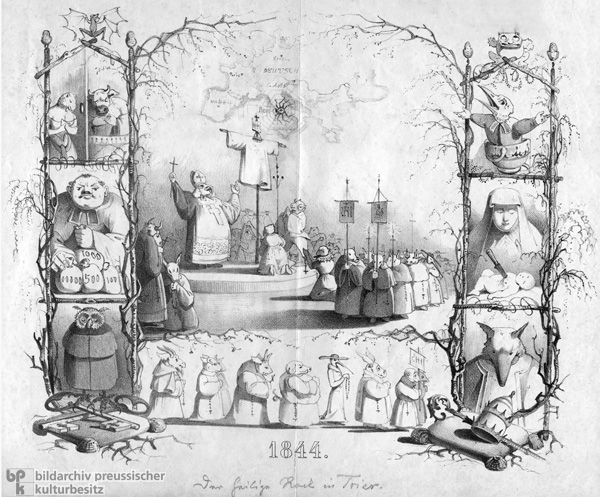|
Der Heilige Rock zu Trier (1844)
In der ersten Hälfte des 19. Jahrhunderts gab es erste Anzeichen für den umfassenden Konflikt zwischen dem preußischen Staat und der römisch-katholischen Kirche, der schließlich in den 1860ern und 1870ern ausbrach und als Kulturkampf in die Geschichte einging. Herausgefordert durch Preußens Beharren auf der Rechtmäßigkeit von „Mischehen“ zwischen Katholiken und Protestanten, der Entstehung einer anti-römischen deutsch-katholischen Bewegung und der Inhaftierung des unnachgiebigen Erzbischofs von Köln 1837, glaubte die römisch-katholische Kirche, sie gewänne wieder die Oberhand, als der preußische König Friedrich Wilhelm IV. (1795-1861) 1840 den Thron bestieg und den meisten Forderungen der Kirche zustimmte. In dieser Atmosphäre gelang 1844 dem Bischof von Trier, Wilhelm Arnoldi (1798-1864), die Mobilisierung etwa einer halben Million Gläubiger zum Aufbruch zu einer Wallfahrt zum Heiligen Rock Christi, der damals öffentlich ausgestellt war. Diese Karikatur ist eine beißende Reaktion auf das, was viele als Obskurantismus und naiven Aberglauben betrachteten. Indem Geistliche und Pilger als Leithammel, Schafe, Esel und andere leichtgläubige Tiere dargestellt werden, verurteilt die Karikatur zudem den finanziellen Aspekt von Wallfahrten und Reliquien. Auf einer Karte im Hintergrund sitzt die „schwarze Spinne“ in Rom und spinnt ihr Intrigennetz. Lithografie eines unbekannten Künstlers, 1844.

|


